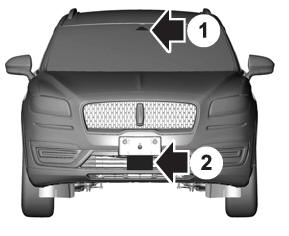Lincoln Nautilus: Seatbelt Systems / Seatbelt Systems - System Operation and Component Description. Description and Operation
System Operation
Emergency Locking Retractor (ELR)
All
retractors have an Emergency Locking Retractor (ELR) mode, which is a
vehicle-sensitive feature designed to activate and lock the seat belt
webbing during hard braking, cornering, or an impact of approximately 24
km/h (14.9 mph). The Emergency Locking Retractor (ELR) feature helps
reduce the forward movement of the driver and passengers. For testing,
see Functional Test - Seatbelt Retractor, Road Test Inspection.
Refer to: Seatbelt Systems (501-20A Seatbelt Systems, Diagnosis and Testing).
Automatic Locking Retractor (ALR)
The
Automatic Locking Retractor (ALR) mode is used when locking a child
seat in any passenger seating position. The Automatic Locking Retractor
(ALR) mode automatically activates when the seatbelt webbing is fully
extracted from the retractor and then allowed to retract. As the
seatbelt webbing retracts back onto the spool, an audible clicking sound
is made, indicating the seatbelt retractor is in Automatic Locking
Retractor (ALR) mode and the seatbelt webbing cannot pull back out of
the seatbelt retractor. The Automatic Locking Retractor (ALR) mode
disengages when the webbing is allowed to fully retract back into the
retractor. For testing, see Functional Test - Seatbelt Retractor,
Automatic Locking Retractor (ALR) Mode.
Refer to: Seatbelt Systems (501-20A Seatbelt Systems, Diagnosis and Testing).
Seatbelt Warning Chime and Indicator
For seatbelt warning chime and indicator operation,
Refer to: Instrument Panel Cluster (IPC) (413-01A)
.
To diagnose the seatbelt warning chime and indicator,
Refer to: Instrumentation, Message Center and Warning Chimes (413-01A)
.
Belt-Minder®
For Belt-Minder® operation,
Refer to: Warning Chimes (413-01A)
.
To diagnose the Belt-Minder® feature,
Refer to: Instrumentation, Message Center and Warning Chimes (413-01A)
.
To activate or deactivate the Belt-Minder® feature,
Refer to:
Seatbelt Minder Deactivating/Activating (413-01 Instrumentation, Message
Center and Warning Chimes, General Procedures).
Rear Occupant Alert System
The rear occupant alert system notifies through visual and audible notifications to check for potential rear seat occupants when the ignition is switched off. This feature is activated through the opening and closing of the rear doors prior to the ignition ON status. This is an operating characteristic of the vehicle and no repairs should be attempted. Refer to the Owner's Literature and rear occupant alert system for system operation and turning the system on and off.
Component Description
Child Safety Seat Tether Anchor
Child safety seat tether anchors are the wires located at the back of the rear seat backrest frame at all rear seating positions.
If
a child safety seat was in use during a collision, inspect the child
safety seat tether anchor and mounting areas and restore the vehicle to
the original production configuration.
Refer to: Seatbelt Procedure After a Collision (501-20A Seatbelt Systems, General Procedures).
Child Safety Seat Tether Anchor - Lower Anchors and Tethers for Children (LATCH)
Lower Anchors and Tethers for Children (LATCH) are the wires that protrude from between where the seat backrest and seat cushion meet.
Lower Anchors and Tethers for Children (LATCH) are part of and serviced with the seat backrest frame.
If
a child safety seat was in use during a collision, inspect the LATCH
and restore the vehicle to the original production configuration.
Refer to: Seatbelt Procedure After a Collision (501-20A Seatbelt Systems, General Procedures).
 Seatbelt Systems. Diagnosis and Testing
Seatbelt Systems. Diagnosis and Testing
Symptom Chart(s)
Diagnostics in this manual assume a certain skill level and knowledge of Ford-specific diagnostic practices. REFER to: Diagnostic Methods (100-00 General Information, Description and Operation)...
Other information:
Lincoln Nautilus 2018-2025 Service Manual: Satellite Radio / Global Positioning System (GPS) Splitter / Cable. Removal and Installation
Removal NOTE: Removal steps in this procedure may contain installation details. Remove the information and entertainment display unit. Remove the ACM . Refer to: Audio Front Control Module (ACM) (415-00 Information and Entertainment System - General Information - Vehicles With: SYNC 4, Removal and Installation)...
Lincoln Nautilus 2018-2025 Service Manual: Microphone. Removal and Installation
Removal NOTE: Removal steps in this procedure may contain installation details. Lower the headliner. Refer to: Headliner - Lowering (501-05 Interior Trim and Ornamentation, Removal and Installation). Disconnect the electrical connector, release the tabs and remove the microphone...
Categories
- Manuals Home
- 1st Generation Nautilus Owners Manual
- 1st Generation Nautilus Service Manual
- Opening and Closing the Hood
- Replacing the Rear Wiper Blades
- Auto Hold
- New on site
- Most important about car
Locating the Pre-Collision Assist Sensors

If a message regarding a blocked sensor or camera appears in the information display, something is obstructing the radar signals or camera images. The radar sensor is behind the fascia cover in the center of the lower grille. With a blocked sensor or camera, the system may not function, or performance may reduce. See Pre-Collision Assist – Information Messages.

